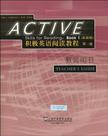积极英语阅读教程
出版时间:2010-2 出版社:上海外教 作者:(美)安德森//赫布利 页数:64
内容概要
《积极英语阅读教程》这套最新版教程的教师用书增设了扩展阅读内容,将阅读能力的培养与听力、口语和写作能力的培养结合起来;提供了4种有用的教学技巧,帮助提高和巩固学习者的阅读流利程度;针对阅读教学领域教师们常提出的问题,Neil J.Anderson作了拨云见日的解答;涵盖了TOEFLR iBT(新托福网络测试)需要的所有阅读技巧,并制作了表格,对每种技巧在积极英语阅读教程中的位置做了定位;最新版提倡“积极阅读”(ACTIVE Reading)的教学方法,以帮助学习者树立自信,成为独立、积极的英语阅读者。 本册为教师用书,第一级,最新版。
作者简介
尼尔·J·安德森是阅读教学方面的专家,本书采用了他设计的ACTIVE阅读法,帮助读者成为更自信、更独立——也是更积极的英语阅读者。
书籍目录
Frequently Asked QuestionsUnit Walkthrough: Getting ReadyUnit Walkthrough: Chapters 1 & 3Unit Walkthrough: Real Life Skill & What Do You Think?Using the Audio ComponentReview Units and Activities for Building Reading RateUnit 1: Our Changing DietUnit 2: InventionsUnit 3: Studying AbroadUnit 4: Money and BudgetsUnit 5: Our Modern LifestyleUnit 6: The Olympic GamesUnit 7: Human AchievementsUnit 8: Language and CommunicationUnit 9: Festivals and CelebrationsUnit 10: Growing Older.Unit 11: Look Into the FutureUnit 12: Folk Tales and HoaxesReview Unit 1Review Unit 2Review Unit 3Review Unit 4IPA Chart and TOEFLR iBT Reading Skills
章节摘录
Integrated Skills Extension: Making a Time BudgetExplain to students that they need to manage their time as well as their money. Use this activity to encouragestudents to track their use of time and develop a practical time budget. 1. Explain that everyone gets only 24 hours in the day and we always spend it. Explain that unlike money you cannot borrow or earn more time to make up for spent time. Make sure students understand that important work in this activity will be done outside of class. 2. Ask each student to write a quick list of categories for how they spend their time, such as class time, study time or homework, part-time job, social activities, recreation or sports, eating and sleeping time. Tell students to write about how much time they spend each day doing each activity. Have students calculate how much free time they have. Have students write their names on the paper and hand it in. 3. Have students work in pairs to find out what categories their partners used. Tell them to note any categories they forgot to use. Some examples include transportation time or time for personal care. 4. For the next week, have each student keep a written log of how they spend time each day. Expect that days will differ according to whether it is a weekday or weekend and the activity schedule. Tell students that after one week they must come to class with a log of how they spent time during the week. Make sure students understand that the log should be organized by categories. 5. When the students bring their one-week time logs, give them back their guesses from the week before. Ask students to compare their actual time with their estimates. Ask them if there are new categories that they didnt think about at first. Give students a few minutes to work alone. Have them get in groups of four to compare and contrast their time logs. Have them discuss ways that they can each use time better. 6. Elicit a class discussion on good student time management. Write student suggestions on the board. Some ideas include.
图书封面
评论、评分、阅读与下载
用户评论 (总计2条)
- 可以自我检查作业。
- 有书所以就买了
